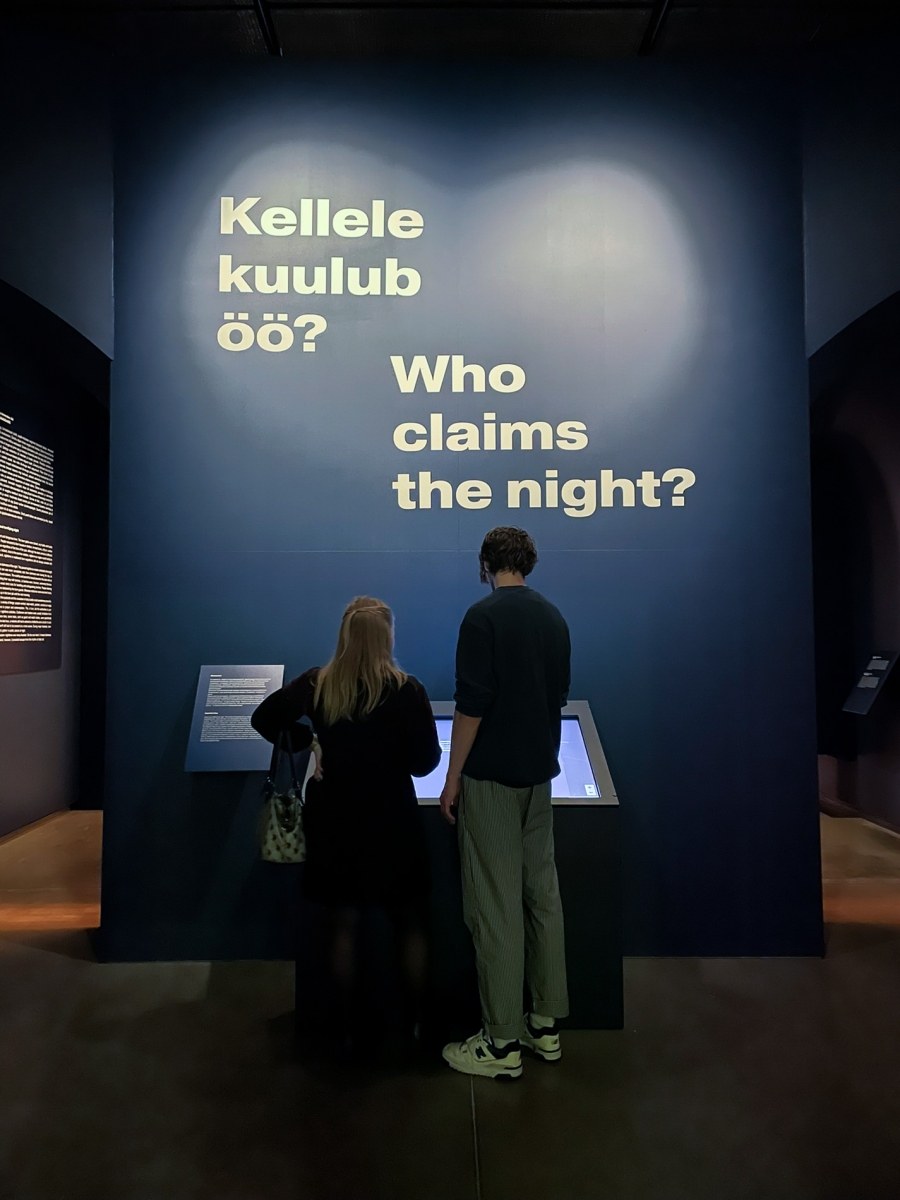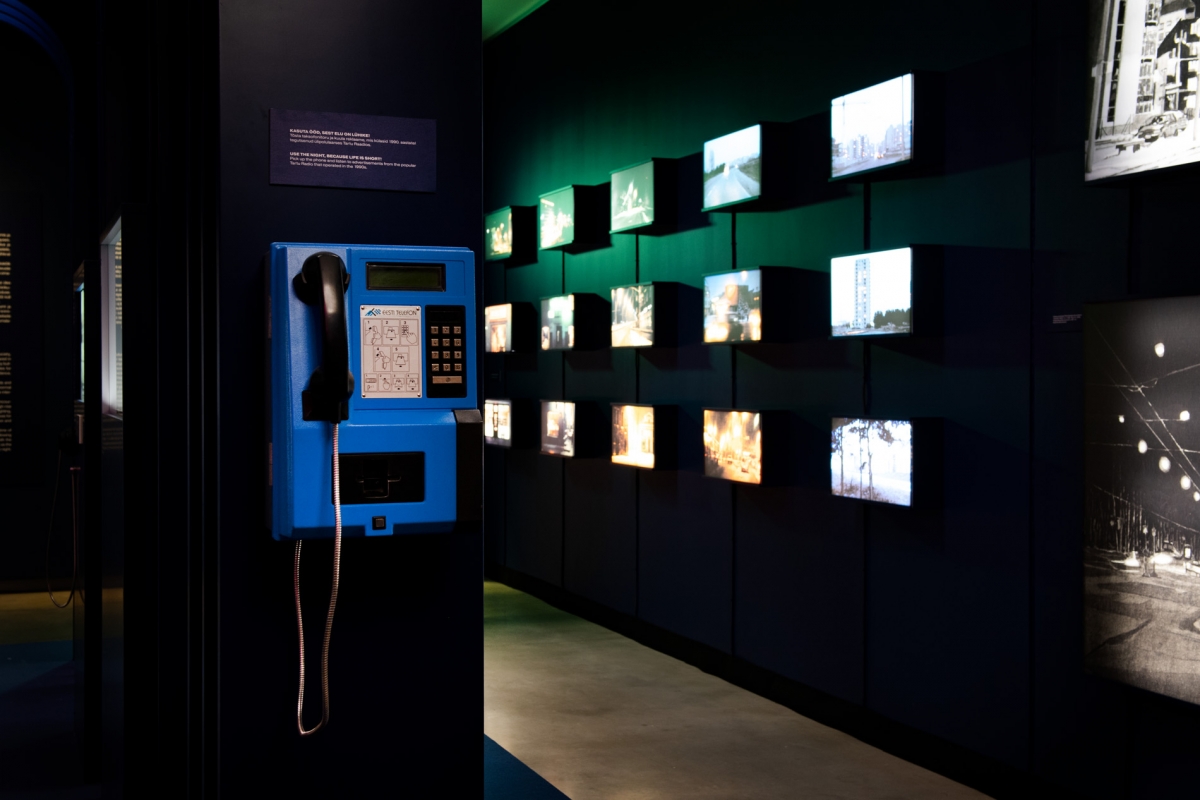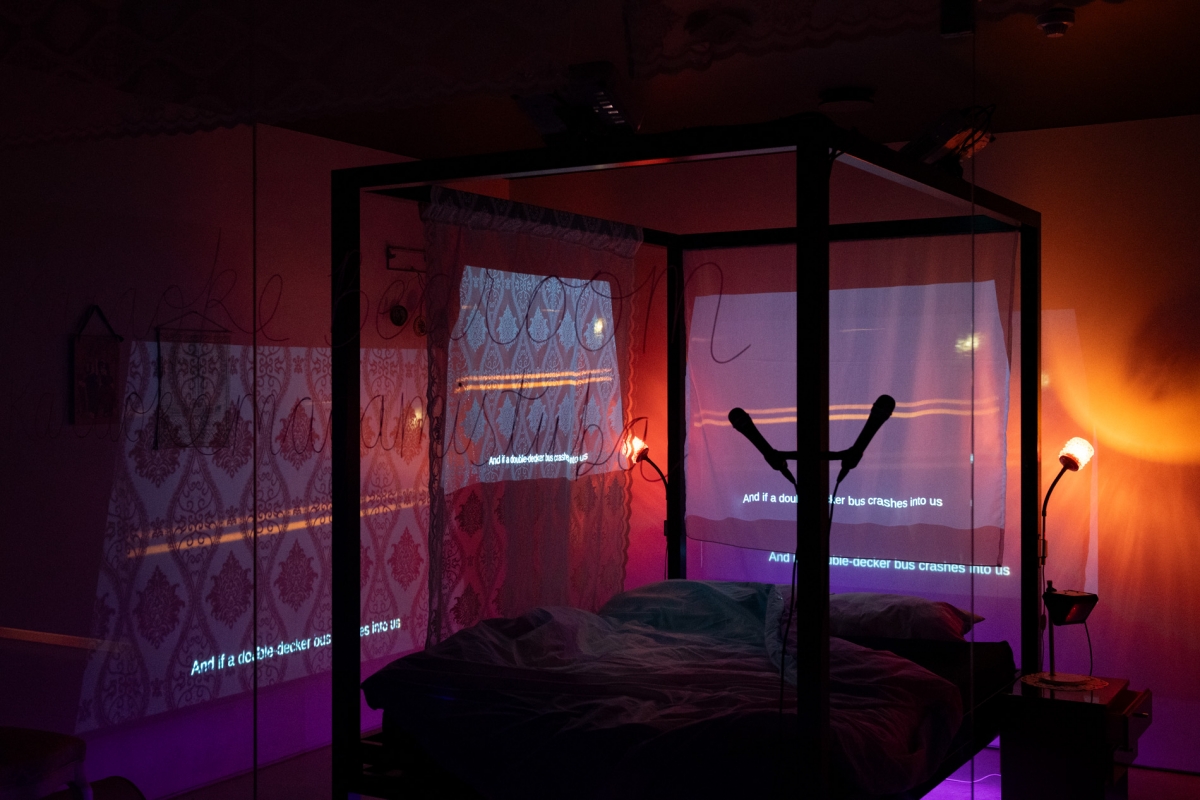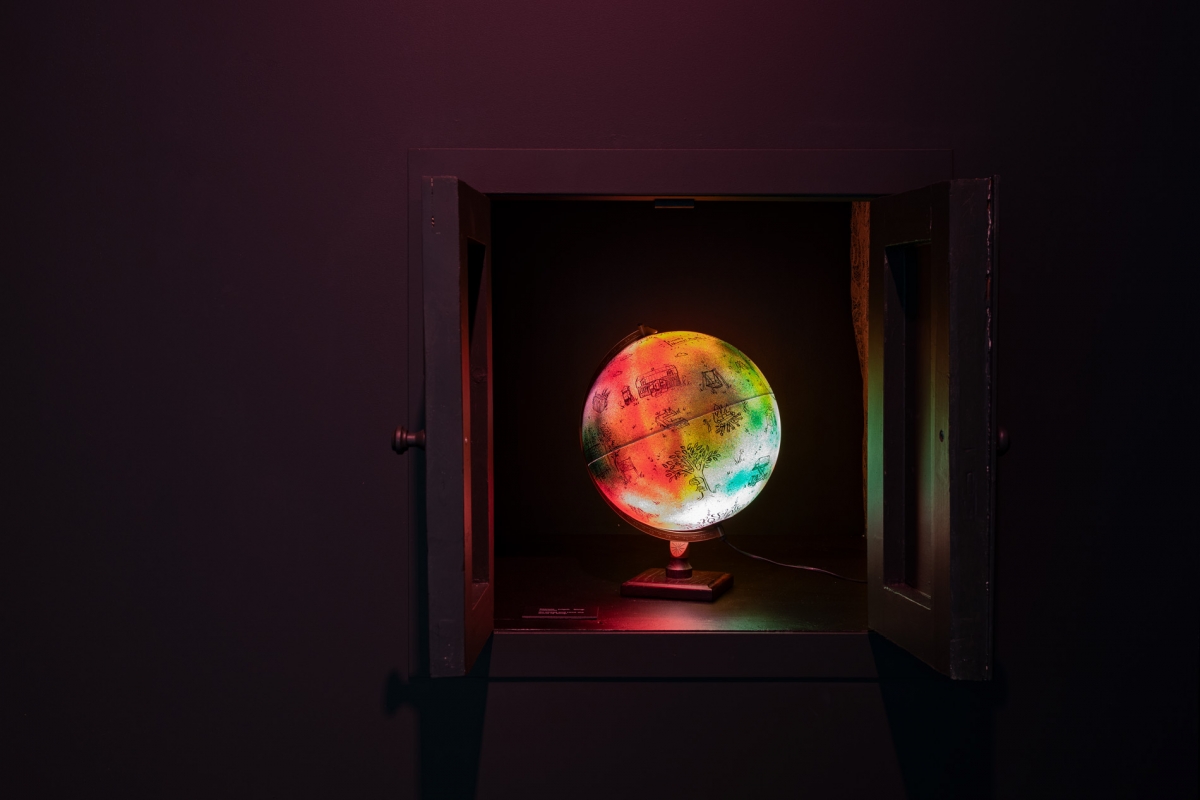Who Claims the Night?
The exhibition is open from 17 February 2024 to 24 February 2025.
The Glimmer and Gloom of Estonian Urban Life After Dark
If darkness was endlessly temporal,
we would never see the light of the sun.
But standing forever in the sun
would bereave us of life in the night.
Arno Vihalemm, ‘Alveri ainetel’ (‘After Alver’)
ABOUT the EXHIBITION
INSTALLATIONS
TEAM
In 2024, the Estonian National Museum will shine a light on city life at night. The exhibition ‘Who Claims the Night?’ explores how people have experienced the night in Estonian cities in the past, and delves into the multitude of meanings of the contemporary night.
Nighttime has rarely been examined as a factor shaping our behaviour. As a result, life at night has hardly ever been studied and recorded. One of the reasons for this is, naturally, darkness, which limits the technical possibilities for recording the nighttime environment. Moreover, darkness tends to give people a sense of anonymity and increased freedom, making them less keen to expose themselves to the researcher’s gaze and recording devices.
Throughout history, night life has been shaped by power and culture. The mediaeval Tallinn locked its gates against the dangers lurking in the night, and sent all townspeople home in the evening without exception, to allow them to wake up rested in the morning. Just 150 or so years ago, the streets were shrouded in darkness, wolves howled in the suburbs... The only ones moving around were the night watchmen tasked with maintaining order and disciplining nightgoers, if necessary. Modern cities and towns, in contrast, are always awake, providing necessary services and diverse forms of cultural life throughout the night.
On the one hand, night life in cities is perceived as a problem and a danger, something to be regulated using laws and restrictions. On the other hand, however, nighttime is perceived as a time of freedom and entertainment, and a different sort of space-time compared to the day. Night life involves sensual pleasures, experimentation, creativity – but also danger and the breaking of rules. The city has its own rhythm and atmosphere at night that has inspired countless artists, writers, and musicians. The night is an exciting and many-sided environment.
INSTALLATIONS
Moments in an Ordinary Night. Carlo Cubero, Patrick McGinley, Ivo Tšetõrkin and Kevin Molloy
This installation consists of observational documentary scenes in spaces where ordinary activities are carried out at night. The piece draws inspiration from perspectives that that seek a non-binary approach to nightlife and emphasise its routine and mundane aspects. The documentary is presented in 360 degree format so as to emphasise on the spatial, rather than moral qualities of nightlife.
Found and lost. Anastasiia Cherkasova, Karin Leivategija, ULM culture club, HALL club
Tallinn at night is a splendid place in time, the backdrop for a diverse and creative cultural life that pushes boundaries in many ways. Here one can discover everything from film and lost-and-found items at club HALL to great music.
Paavo Matsin ja Andra Rahe
One place, two perspectives - – two different artists' visions of the same locations. Can you recognize them?
There is an Echo in Me
An installation by Piibe Kolka, Élisabeth de Bézenac and Natalie Marr, inspired by nocturnal intimacies, late night encounters, and dreams and visions that come from the dark. Like a sunset, it softly lulls the visitor down to the basement of the museum, a place where memories, desires and old bedroom furniture are stored away from public sight. Here, ghosts and shadows of past parties flash by, the remnants of lost loves or brief encounters perhaps. A bedroom filled with lights and sounds of a karaoke club, draws us deeper into the night and to each other. Continue on to find an old jukebox glimmering in the toilets, where you can select a song to sing. Along the way, a jumbled basement archive holds many midnight pleasures and embarrassments that appear and disappear in the sad flicker of neon light. Open a drawer or two, have a snoop around. Go on. Go deeper. Elsewhere, a dreamcatcher sparkles in the soft darkness, adorned with party gowns and materials for shapeshifting. Re-enact lost dreams, fall in love with your shadow, or simply delight in the ecstasy of shimmer. Inside the dreamcatcher, a late night radio station whispers into the dark, weaving lonely listeners into its tight embrace. Stay for a while, perhaps tomorrow will be okay.
TEAM
Lead curator: Karin Leivategija
Co-curators: Inna Jürjo, Aet Kuusik, Anu Kannike, Meeri Ott, Riho Paramonov, Oskar Poll, Rebeka Põldsam, Lauri Suurmaa, Katrin Tiidenberg
Exhibition designer: Emma Eensalu
Assistant artist: Silver Rannak
Exhibition team (Estonian National Museum): Laura Kipper, Viljar Pohhomov, Lauri Tamm, Tiit Sibul, Piret Simson, Reet Mark, Arvi Tragel, Ülle Jäe, Kristiina Piirisild, Eve Keedus, Karl-Erik Hiiemaa, Mirjam Ruutma, Karoliine Bürkland, Silli Peedosk, Eve Kasearu, Kadri Tomasson, Kersti Kilk, Pihel Prants, Taavi Toom, Oliver Kulpsoo, Avo Anni, Kristjan Käkki, Aivi Jürgenson
Sound artists: Mihkel Maripuu, Taavi Tulev
Light artists: Mikk-Mait Kivi, Oliver Kulpsoo
Video- and sound installation “Finally Dance”: Mikk-Mait Kivi ja Mihkel Maripuu
Short film “Night of Purple Horrors”: Kadri Nikopensius, Rebeka Põldsam, Aet Kuusik
Street artist: Sänk (Danil Taro)
Production: Fratelli Grupi OÜ, Futuremedia OÜ, Salibar OÜ, Swat Systems OÜ
Installers: Piret Hirv, Kristiina Laurits, Eve Margus, Villu Plink
Prop master: Kaie Uustal
Editor: Karin Kastehein
Translations: tõlkebüroo Avatar
Nightlife map: Mobi Lab OÜ
Consultants: Tomas Alexandersson (The Tallinn Collector), Hilkka Hiiop
Our thanks to everyone who contributed to the preparation and success of the exhibition.
Attention! The exhibition also deals with sexuality, nudity and violence. We recommend that children watch the exhibition with an adult.
Nighttime has rarely been examined as a factor shaping our behaviour. As a result, life at night has hardly ever been studied and recorded. One of the reasons for this is, naturally, darkness, which limits the technical possibilities for recording the nighttime environment. Moreover, darkness tends to give people a sense of anonymity and increased freedom, making them less keen to expose themselves to the researcher’s gaze and recording devices.
Throughout history, night life has been shaped by power and culture. The mediaeval Tallinn locked its gates against the dangers lurking in the night, and sent all townspeople home in the evening without exception, to allow them to wake up rested in the morning. Just 150 or so years ago, the streets were shrouded in darkness, wolves howled in the suburbs... The only ones moving around were the night watchmen tasked with maintaining order and disciplining nightgoers, if necessary. Modern cities and towns, in contrast, are always awake, providing necessary services and diverse forms of cultural life throughout the night.
On the one hand, night life in cities is perceived as a problem and a danger, something to be regulated using laws and restrictions. On the other hand, however, nighttime is perceived as a time of freedom and entertainment, and a different sort of space-time compared to the day. Night life involves sensual pleasures, experimentation, creativity – but also danger and the breaking of rules. The city has its own rhythm and atmosphere at night that has inspired countless artists, writers, and musicians. The night is an exciting and many-sided environment.
INSTALLATIONS
Moments in an Ordinary Night. Carlo Cubero, Patrick McGinley, Ivo Tšetõrkin and Kevin Molloy
This installation consists of observational documentary scenes in spaces where ordinary activities are carried out at night. The piece draws inspiration from perspectives that that seek a non-binary approach to nightlife and emphasise its routine and mundane aspects. The documentary is presented in 360 degree format so as to emphasise on the spatial, rather than moral qualities of nightlife.
Found and lost. Anastasiia Cherkasova, Karin Leivategija, ULM culture club, HALL club
Tallinn at night is a splendid place in time, the backdrop for a diverse and creative cultural life that pushes boundaries in many ways. Here one can discover everything from film and lost-and-found items at club HALL to great music.
Paavo Matsin ja Andra Rahe
One place, two perspectives - – two different artists' visions of the same locations. Can you recognize them?
There is an Echo in Me
An installation by Piibe Kolka, Élisabeth de Bézenac and Natalie Marr, inspired by nocturnal intimacies, late night encounters, and dreams and visions that come from the dark. Like a sunset, it softly lulls the visitor down to the basement of the museum, a place where memories, desires and old bedroom furniture are stored away from public sight. Here, ghosts and shadows of past parties flash by, the remnants of lost loves or brief encounters perhaps. A bedroom filled with lights and sounds of a karaoke club, draws us deeper into the night and to each other. Continue on to find an old jukebox glimmering in the toilets, where you can select a song to sing. Along the way, a jumbled basement archive holds many midnight pleasures and embarrassments that appear and disappear in the sad flicker of neon light. Open a drawer or two, have a snoop around. Go on. Go deeper. Elsewhere, a dreamcatcher sparkles in the soft darkness, adorned with party gowns and materials for shapeshifting. Re-enact lost dreams, fall in love with your shadow, or simply delight in the ecstasy of shimmer. Inside the dreamcatcher, a late night radio station whispers into the dark, weaving lonely listeners into its tight embrace. Stay for a while, perhaps tomorrow will be okay.
TEAM
Lead curator: Karin Leivategija
Co-curators: Inna Jürjo, Aet Kuusik, Anu Kannike, Meeri Ott, Riho Paramonov, Oskar Poll, Rebeka Põldsam, Lauri Suurmaa, Katrin Tiidenberg
Exhibition designer: Emma Eensalu
Assistant artist: Silver Rannak
Exhibition team (Estonian National Museum): Laura Kipper, Viljar Pohhomov, Lauri Tamm, Tiit Sibul, Piret Simson, Reet Mark, Arvi Tragel, Ülle Jäe, Kristiina Piirisild, Eve Keedus, Karl-Erik Hiiemaa, Mirjam Ruutma, Karoliine Bürkland, Silli Peedosk, Eve Kasearu, Kadri Tomasson, Kersti Kilk, Pihel Prants, Taavi Toom, Oliver Kulpsoo, Avo Anni, Kristjan Käkki, Aivi Jürgenson
Sound artists: Mihkel Maripuu, Taavi Tulev
Light artists: Mikk-Mait Kivi, Oliver Kulpsoo
Video- and sound installation “Finally Dance”: Mikk-Mait Kivi ja Mihkel Maripuu
Short film “Night of Purple Horrors”: Kadri Nikopensius, Rebeka Põldsam, Aet Kuusik
Street artist: Sänk (Danil Taro)
Production: Fratelli Grupi OÜ, Futuremedia OÜ, Salibar OÜ, Swat Systems OÜ
Installers: Piret Hirv, Kristiina Laurits, Eve Margus, Villu Plink
Prop master: Kaie Uustal
Editor: Karin Kastehein
Translations: tõlkebüroo Avatar
Nightlife map: Mobi Lab OÜ
Consultants: Tomas Alexandersson (The Tallinn Collector), Hilkka Hiiop
Our thanks to everyone who contributed to the preparation and success of the exhibition.
Attention! The exhibition also deals with sexuality, nudity and violence. We recommend that children watch the exhibition with an adult.






